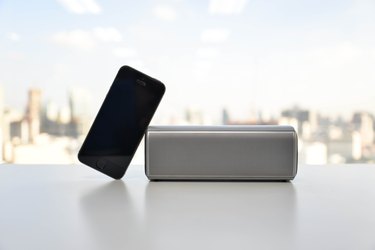
Bluetooth is a wireless communications technology that allows electronic devices, such as computers and cellular phones, to exchange data over short distances. Bluetooth uses the 2.4 gigahertz (GHz) band of the radio frequency spectrum, otherwise known as the industrial, medical and scientific (ISM) band, which is unlicensed in most countries.
Unintentional Radiation
Video of the Day
Bluetooth is a robust communications technology insofar as it includes mechanisms for error-checking and correction. However, while minor sources of electromagnetic interference, such as personal computers, are unlikely to cause interference with Bluetooth signals, other devices that share the ISM band, including microwave ovens, can cause serious interference. In extreme circumstances, such as setting down a Bluetooth device close to a microwave oven while it is operating, interference can block Bluetooth signals altogether.
Video of the Day
Wi-Fi
Wi-Fi devices are officially identified by the Institute of Electrical and Electronics Engineers (IEEE) 802.11 family of standards. Of the four versions of 802.11 technology available, three of them—802.11b, 802.11g and 802.11n—operate in the ISM band. Bluetooth and Wi-Fi coexist in a section of the ISM that is 83 megahertz (MHz) wide, and Bluetooth uses a technique, known as "frequency hopping spread spectrum," to "hop" among 79 different channels in this section. A simultaneous Wi-Fi transmission occupies 22 of these channels, and so can lead to interference ranging from slowing of the data rate to complete blocking of Bluetooth communications, depending on the strength of the signal.
Cellular Phone
A Bluetooth receiver in a cellular phone can also be blocked by the cellular phone transmitter. Typical Global System for Mobile Communications (GSM) cellular phone transmitters output between one and three watts, but Bluetooth receivers are designed to operate with signals in the order of trillionths of a watt, or picowatts, so the receiver can be completely overwhelmed by the transmitter. Even in a best-case scenario, the GSM transmitter generates significant noise, which limits the range of Bluetooth communications.
Denial of Service
Bluetooth networks, technically known as piconets, may also be susceptible to so-called denial-of-service attacks, in which an intruder seeks to deliberately block, or jam, Bluetooth signals. Denial-of-service attacks can take place at the physical layer, where an intruder may attempt to capture a channel from a bona fide member of the piconet, or within the framework of protocols, or sets of rules, that control Bluetooth communication. In the latter case, an intruder may exploit some of the characteristics of Bluetooth to flood one or more members of a piconet with network traffic, so that that device cannot communicate with other devices.